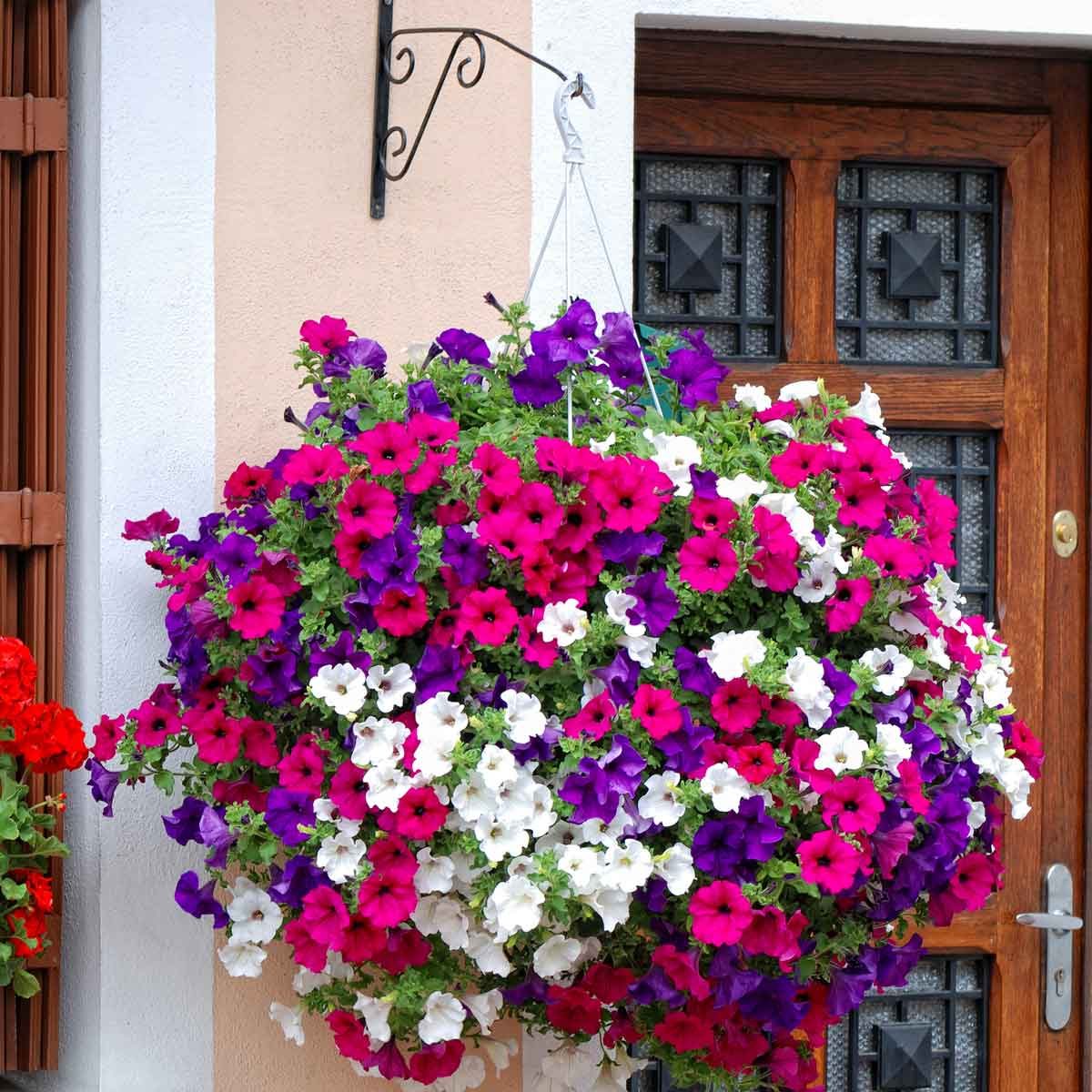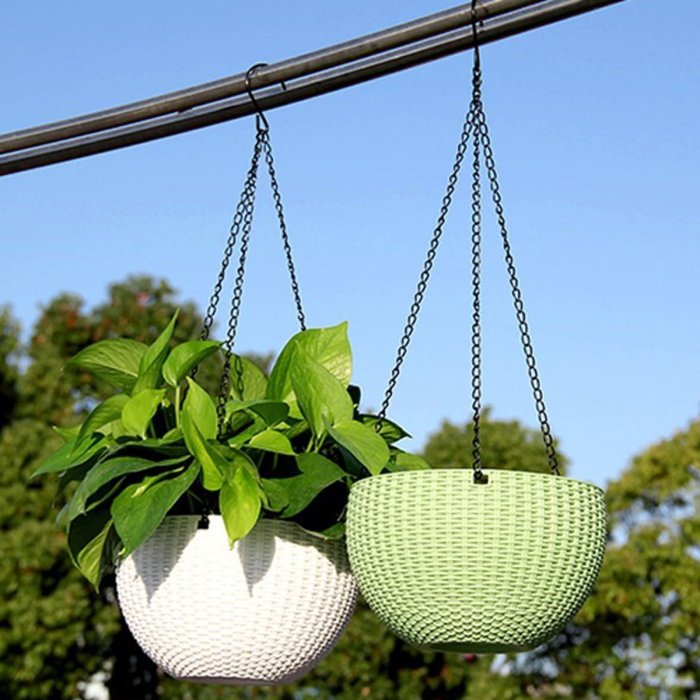10 hanging plants outdoor – Step into a world of verdant beauty as we unveil 10 captivating hanging plants that will elevate your outdoor spaces to new heights. From cascading ferns to vibrant blooms, these botanical wonders will bring life and color to your patios, balconies, and gardens.
These versatile plants not only add aesthetic charm but also offer practical benefits, such as purifying the air, providing shade, and attracting pollinators. Whether you’re a seasoned gardener or a novice, this guide will equip you with the knowledge and inspiration to create breathtaking hanging gardens that will leave a lasting impression.
Hanging Plant Varieties for Outdoor Spaces

Hanging plants add a touch of greenery and beauty to any outdoor space. Whether you have a balcony, patio, or porch, there are many different types of hanging plants that can thrive in these environments. Here is a comprehensive list of 10 popular hanging plant species suitable for outdoor spaces:
- Trailing Petunias: These popular annuals produce a profusion of colorful blooms in shades of pink, purple, red, and white. They prefer full sun to partial shade and well-drained soil.
- Fuchsia: These elegant plants feature bell-shaped flowers in various colors, including pink, purple, and white. They prefer partial shade to full shade and moist, well-drained soil.
- Impatiens: These shade-loving plants produce a continuous bloom of impatiens in shades of pink, red, purple, and white. They prefer partial shade to full shade and moist, well-drained soil.
- Begonias: These versatile plants come in a variety of forms, including hanging baskets. They produce beautiful flowers in shades of pink, red, white, and yellow. They prefer partial shade to full shade and moist, well-drained soil.
- Lantana: These heat-tolerant plants produce clusters of small, colorful flowers in shades of yellow, orange, pink, and purple. They prefer full sun to partial shade and well-drained soil.
- Lobelia: These trailing plants produce a profusion of small, blue or purple flowers. They prefer full sun to partial shade and moist, well-drained soil.
- Vinca: These trailing plants produce a continuous bloom of small, white or pink flowers. They prefer full sun to partial shade and well-drained soil.
- Million Bells: These vigorous plants produce a profusion of small, bell-shaped flowers in shades of pink, purple, red, and white. They prefer full sun to partial shade and well-drained soil.
- Sweet Potato Vine: These trailing plants produce attractive foliage in shades of green, purple, and bronze. They prefer full sun to partial shade and well-drained soil.
- Spider Plant: These easy-care plants produce long, trailing leaves with variegated green and white stripes. They prefer bright indirect light and well-drained soil.
Hanging Basket Design and Selection

Hanging baskets are a versatile way to add greenery and color to outdoor spaces. They can be used to create vertical gardens, add height to patios and balconies, or simply provide a touch of nature to any outdoor setting.
There are a variety of hanging baskets available on the market, each with its own advantages and disadvantages. Here is a brief overview of the most common types:
Materials
- Wire basketsare lightweight and durable, making them a good choice for windy areas. They are also relatively inexpensive.
- Plastic basketsare another lightweight option that is easy to clean and maintain. They come in a variety of colors and styles, so you can find one that matches your décor.
- Ceramic basketsare heavy and durable, but they can be more expensive than other types of baskets. They are also more likely to break if they are dropped or knocked over.
When choosing a hanging basket, it is important to consider the size and weight of the plants you will be planting. You will also need to decide where you will be hanging the basket and how much sunlight it will receive.
Design
Once you have chosen a basket, you can start to design your arrangement. Here are a few tips:
- Use a variety of plants with different colors and textures to create a visually appealing arrangement.
- Consider the height and shape of the plants when arranging them in the basket.
- Water the plants regularly and fertilize them according to the manufacturer’s instructions.
Hanging Plant Care and Maintenance: 10 Hanging Plants Outdoor

Hanging plants require specific care and maintenance to thrive in their elevated environment. Understanding their unique needs ensures optimal health and longevity.
Regular watering is crucial for hanging plants. Since they have less soil volume to retain moisture, they dry out faster than ground-level plants. Use well-draining soil to prevent waterlogging and root rot. Water thoroughly, allowing excess to drain out. Adjust watering frequency based on plant type, sunlight exposure, and temperature.
Fertilization
Fertilizing hanging plants provides essential nutrients for growth and vitality. Choose a balanced liquid fertilizer and dilute it according to the manufacturer’s instructions. Fertilize monthly during the growing season, reducing frequency during winter months.
Hanging plants are a great way to add life and color to any outdoor space. Whether you have a small patio or a large backyard, there are many different types of hanging plants that will thrive in your environment. If you have high ceilings, you may want to consider some of the larger varieties of hanging plants, such as ferns or ivy.
For those with lower ceilings, there are plenty of smaller options available, such as succulents or air plants. No matter what your space or style, there’s sure to be a hanging plant that’s perfect for you. Click here for more information on 10 hanging plants high ceiling.
With so many different options to choose from, you’re sure to find the perfect hanging plants to add a touch of greenery to your outdoor space.
Pest Control, 10 hanging plants outdoor
Hanging plants are susceptible to pests, especially spider mites, mealybugs, and aphids. Inspect plants regularly and isolate any affected ones. Use insecticidal soap or neem oil to control infestations.
Pruning and Repotting
Regular pruning encourages new growth and prevents leggy plants. Remove dead or damaged leaves and stems. Repotting is necessary when plants outgrow their containers or become rootbound. Choose a slightly larger pot with fresh potting mix to accommodate the expanded root system.
Potential Problems and Solutions
Hanging plants may encounter issues such as wilting, yellowing leaves, or root rot. Wilting can indicate dehydration or excessive sunlight. Yellowing leaves may suggest nutrient deficiency or overwatering. Root rot results from prolonged waterlogging and can be prevented by using well-draining soil and avoiding overwatering.
Vertical Gardening with Hanging Plants

Hanging plants offer a unique opportunity to create lush vertical gardens in outdoor spaces, transforming patios, balconies, and other areas into verdant oases. Vertical gardening maximizes space utilization, allowing for the cultivation of a wide variety of plants in even the most compact areas.
Transform your outdoor space with 10 captivating hanging plants that will add a touch of elegance and tranquility to your surroundings. These resilient plants thrive in the great outdoors, offering a vibrant and eye-catching display. However, if you encounter challenges with your hanging plants, refer to our comprehensive guide, 10 hanging plants keep dying , for expert advice on troubleshooting and reviving your beloved greenery.
Once your plants are flourishing, they will continue to enhance your outdoor oasis, creating a serene and inviting atmosphere.
Benefits of Vertical Gardening
Vertical gardens provide several benefits:
- Space-Saving:Vertical gardens utilize vertical space, allowing for the cultivation of more plants in a limited area.
- Improved Aesthetics:Hanging plants add visual interest and create a lush, inviting atmosphere in outdoor spaces.
- Enhanced Privacy:Vertical gardens can provide privacy by screening off undesirable views or creating a sense of enclosure.
Designing and Installing Vertical Gardens
Designing and installing vertical gardens using hanging plants involves several considerations:
Trellis Systems
Trellis systems provide support for climbing plants, allowing them to grow vertically. Trellises can be made from various materials, including wood, metal, or plastic, and can be customized to fit the specific needs of the space.
Wall-Mounted Planters
Wall-mounted planters are another option for creating vertical gardens. These planters are attached directly to walls, allowing for the cultivation of plants without taking up floor space. Wall-mounted planters come in a variety of sizes, shapes, and materials, providing flexibility in design.
Plant Selection
When selecting plants for vertical gardens, it is important to consider their growth habit and size. Trailing plants, such as petunias, lobelia, and trailing begonias, are ideal for vertical gardens as they cascade down, creating a lush effect. Climbing plants, such as ivy, clematis, and morning glories, can be trained to grow up trellises, adding height and structure to the garden.
Maintenance
Vertical gardens require regular maintenance, including watering, fertilizing, and pruning. It is important to ensure that the plants receive adequate sunlight and water, and to prune them regularly to control their growth and shape.
Creative Uses for Hanging Plants
Hanging plants offer a versatile and creative way to enhance outdoor spaces, adding a touch of greenery and vibrancy to any setting. Beyond their aesthetic appeal, hanging plants can also serve practical functions, such as creating privacy screens and enhancing the ambiance of outdoor gatherings.
Here are some innovative ideas for incorporating hanging plants into your outdoor décor:
Privacy Screens
Hanging plants can be strategically placed to create natural privacy screens, blocking unsightly views or creating a sense of seclusion in outdoor areas. Large, trailing plants like ivy or ferns are ideal for this purpose, as they can effectively cover fences or walls.
Vertical Gardening
Hanging plants can be used to create vertical gardens, adding a touch of greenery to walls, patios, or balconies. This is an excellent way to maximize space in small outdoor areas and create a lush, living wall.
Suspended Planters
Suspended planters are a creative way to display hanging plants, creating a floating effect that adds visual interest to outdoor spaces. These planters can be hung from trees, beams, or hooks, and can accommodate a variety of plant species.
For those looking to spruce up their outdoor spaces, hanging plants offer a vibrant and versatile solution. From cascading ferns to trailing succulents, there are countless options to choose from. But if you’re seeking indoor greenery, be sure to check out 10 hanging plants indoor for inspiration.
With their lush foliage and air-purifying qualities, these indoor plants will transform any room into a serene oasis. And for the ultimate outdoor display, consider incorporating these 10 hanging plants into your garden or patio.
Macrame Hangers
Macrame hangers are a bohemian-inspired way to display hanging plants, adding a touch of texture and style to outdoor spaces. These hangers can be made from various materials, such as cotton or jute, and come in a variety of designs and colors.
Wall-Mounted Terrariums
Wall-mounted terrariums are a unique and eye-catching way to incorporate hanging plants into outdoor spaces. These terrariums can be made from glass or acrylic and are designed to create a miniature ecosystem for plants.
Final Conclusion
As we conclude our journey into the realm of hanging plants, remember that these botanical companions are not mere decorations but living wonders that bring joy and tranquility to our outdoor spaces. Embrace their beauty, care for them with love, and let them transform your surroundings into an enchanting oasis where nature’s artistry unfolds.
FAQ
How often should I water hanging plants?
Watering frequency depends on the plant species and weather conditions. Generally, water when the top inch of soil feels dry to the touch.
Do hanging plants need sunlight?
Most hanging plants prefer bright, indirect light. However, some varieties can tolerate low light or even full sun.
How do I create a vertical garden with hanging plants?
Use trellis systems, wall-mounted planters, or macrame hangers to attach hanging plants to vertical surfaces, creating a stunning and space-saving display.